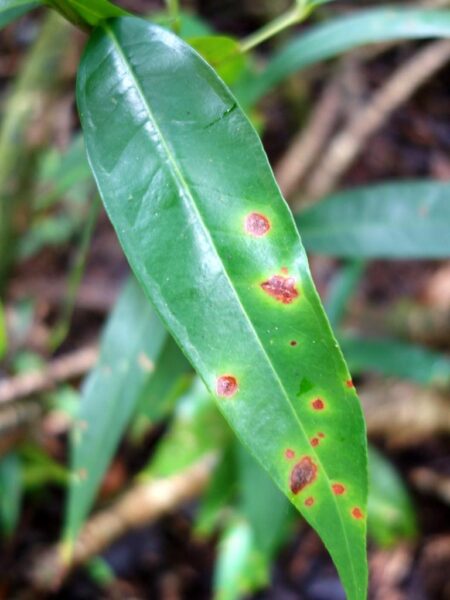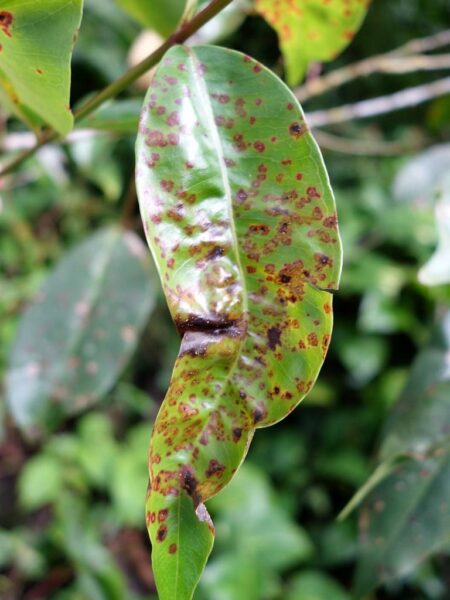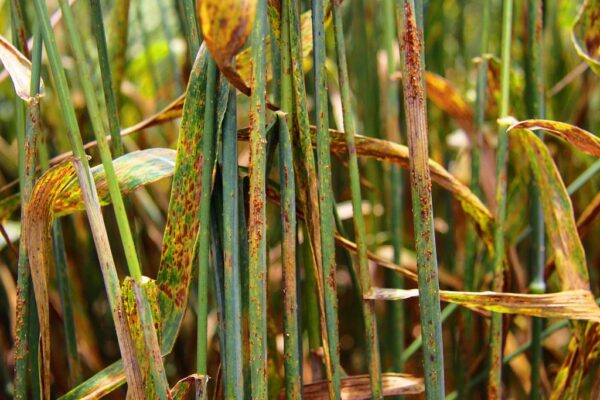
Rust (Puccinia spp.)
Rust diseases, caused by various fungi including Puccinia, Uromyces, and others, significantly impact a wide range of plants, including turfgrasses, cereal crops, currants, and asparagus. These diseases manifest as rust-colored pustules on the plants and can lead to substantial damage and yield loss.
Stem Rust (Puccinia graminis)
- Affected Plants: Primarily affects cereal crops like wheat and barley.
- Symptoms: Produces large, reddish-brown pustules on stems and leaves.
- Management Tips: Use of resistant crop varieties is key. Crop rotation and timely application of fungicides can also help manage outbreaks.
Common Corn Rust (Puccinia sorghi)
- Affected Plants: Targets corn.
- Symptoms: Forms brownish to reddish pustules on corn leaves.
- Management Tips: Plant resistant varieties where available, and apply fungicides when necessary. Improved field sanitation and crop rotation can reduce spore viability.
Leaf Rust of Wheat (Puccinia triticina)
- Affected Plants: Wheat.
- Symptoms: Small, orange-red pustules on the leaves.
- Management Tips: Planting resistant wheat varieties, practicing crop rotation, and applying fungicides can control this disease.
Crown Rust of Oats (Puccinia coronata)
- Affected Plants: Oats.
- Symptoms: Produces orange pustules on leaves and stems.
- Management Tips: Use of resistant oat varieties, crop rotation, and fungicide applications are effective management strategies.
Yellow Rust (Puccinia striiformis)
- Affected Plants: Wheat, barley, and other cereals.
- Symptoms: Yellowish or orange blister-like pustules on the leaves.
- Management Tips: Growing resistant varieties, applying fungicides early in the disease cycle, and eliminating volunteer plants can reduce the disease impact.
Currant Rust (Puccinia ribesii-var. grossulariae)
- Affected Plants: Currants and gooseberries.
- Symptoms: Bright orange to yellow pustules on the undersides of leaves, which can lead to leaf drop and reduced vigor of the plant.
- Management Tips: Planting resistant currant and gooseberry varieties is crucial for prevention. Regular monitoring and removal of infected leaves or plants help minimize the spread. Ensure proper spacing and pruning to improve air circulation and reduce humidity around the plants. Fungicide applications, as per local guidelines, may be necessary in severe infestations or as a preventive measure during damp seasons.
Asparagus Rust (Puccinia asparagi)
- Affected Plants: Asparagus.
- Symptoms: Starts with small, yellow spots on spears and foliage, progressing to orange-yellow to brownish rust pustules that can cause defoliation and reduced vigor.
- Management Tips: Plant resistant asparagus varieties and practice good sanitation by removing infected debris. Ensure proper spacing for air circulation and use drip irrigation to keep foliage dry. Apply fungicides according to local guidelines, especially during humid conditions.
Turfgrass Rust (Various Puccinia spp.)
- Affected Plants: Common in perennial ryegrass, Kentucky bluegrass, and tall fescue.
- Symptoms: Yellow spots on blades evolving into reddish-brown or orange pustules. Infected turf may thin and weaken.
- Management Tips: Ensure optimal turf health through proper fertilization, mowing, and irrigation. Use rust-resistant grass varieties if possible. Avoid over-watering and water early to allow leaves to dry. Consider fungicides in severe cases, following local guidelines.
General Management Principles Across Different Types of Puccinia
- Resistant Varieties: Always prioritize the use of plant varieties that are genetically resistant to specific rust diseases. Plant breeding programs are continually developing more resistant varieties.
- Cultural Practices: Good cultural practices, such as optimal planting density, proper irrigation techniques, and appropriate fertilizer application, can significantly reduce disease incidence.
- Sanitation: Remove and destroy infected plant debris at the end of the season to reduce the source of spores for next year’s crop.
- Fungicides: When necessary, apply fungicides according to the specific rust disease and crop type. Always follow local guidelines and regulations regarding fungicide use.
- Monitoring: Regular monitoring of plants for early signs of rust infection can help in applying control measures before the disease spreads extensively.
- Biocontrol Methods: Explore biocontrol options where available. Certain fungi and bacteria are known to be antagonistic to rust pathogens and can be used as part of an integrated pest management (IPM) strategy.
- Environmental Management: Since rust fungi thrive in specific environmental conditions, altering the microclimate around susceptible plants can reduce disease severity. This includes watering in the morning to allow leaves to dry during the day and improving air circulation among plants.
In managing rust diseases, understanding the specific life cycle and preferences of the rust fungus affecting your plants is crucial. By adopting integrated disease management practices, including cultural, biological, and chemical methods, the impact of rust diseases can be significantly mitigated, ensuring the health and productivity of affected plants.


